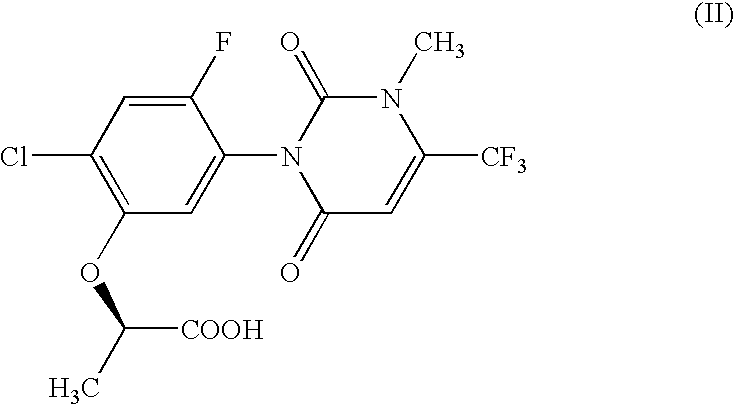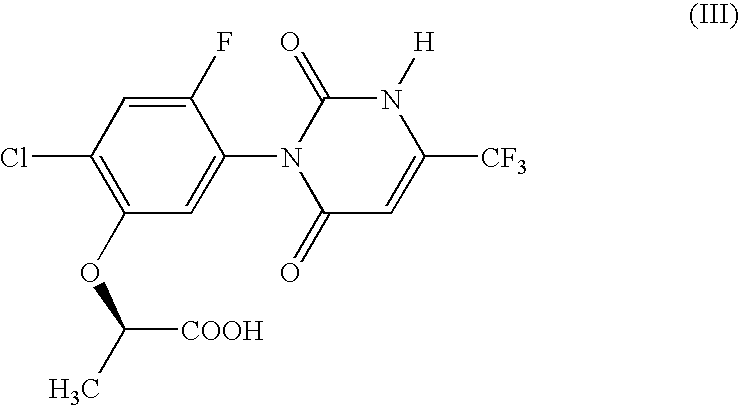Weed controller metabolism proteins, genes thereof and use of the same
a technology of metabolism proteins and weeds, applied in the field of weed controller metabolism proteins, genes thereof, can solve the problems of small effects of left-over solutions or residues on the environment or crops, and it is difficult to distinguish cultivated plants from weeds of allied species
- Summary
- Abstract
- Description
- Claims
- Application Information
AI Technical Summary
Problems solved by technology
Method used
Image
Examples
example 1
The Metabolism of Compound (II) by a Microorganism
(I) Metabolism of Compound (II)
[0903] The various microorganisms shown in Tables 1 and 2 were grown in ISP2 agar medium (1.0%(w / v) malt extract, 0.4%(w / v) yeast extract, 0.4% (w / v) glucose, 2.0%(w / v) agar, pH 7.3). A “loopful” of the each microorganism was added to TGY medium (0.5%(w / v) tryptone, 0.5%(w / v) yeast extract, 0.1%(w / v) glucose, 0.01%(w / v) KH2PO4, pH 7.0) and incubated with shaking at 30° C. for 2 to 4 days. One-tenth milliliter (0.1 ml) of the obtained culture was incubated with shaking in 3 ml of sporulation medium (0.1%(w / v) of meat extract, 0.2%(w / v) tryptose, 1% glucose, pH 7.1) containing compound (II) at 100 ppm for 7 to 8 days at 30° C. Fifty microliters (50 μl) of 2N HCl was added to the resulting culture and this was exacted with 3 ml of ethyl acetate. The obtained ethyl acetate layer was analyzed on the HPLC. The concentration of compound (II) was reduced (column retention time of 23.9 minutes) and new peaks ...
example 2
Preparation of the Present Invention Protein (A1)
(1) Preparation of the Crude Cell Extract
[0910] A frozen stock of Streptomyces phaeochromogenes IFO12898 was added to 100 ml of A medium (0.1%(w / v) glucose, 0.5%(w / v) tryptone, 0.5%(w / v) yeast extract, 0.1%(w / v) of dipotassium hydrogenphosphate, pH7.0) in a 500 ml triangular flask and incubated with rotary shaking at 30° C. for 1 day to obtain a pre-culture. Eight milliliters (8 ml) of the pre-culture was added to 200 ml of A medium and was incubated with rotary shaking in 500 ml a baffled flask at 30° C. for 2 days. Cell pellets were recovered by centrifuging (3,000 g, 5 mm.) the resulting culture. These cell pellets were suspended in 100 ml of B medium (1% (w / v) glucose, 0.1% beef extract, 0.2%(w / v) tryptose) containing compound (II) at 100 ppm and were incubated with reciprocal shaking in a 500 ml Sakaguchi flask for 16 hours at 30° C. Cell pellets were recovered by centrifuging (3,000 g, 5 min.) 10 L of the resulting culture. T...
example 3
Obtaining the Present Invention DNA (A1)
(1) Preparation of the Chromosomal DNA of Streptomyces phaeochromogenes IFO12898
[0918]Streptomyces phaeochromogenes IFO12898 was incubated with shaking at 30° C. for 1 day to 3 days in 50 ml of YEME medium (0.3%(w / v) yeast extract, 0.5%(w / v) bacto-peptone, 0.3%(w / v) malt extract, 1.0%(w / v) glucose, 34%(w / v) sucrose and 0.2%(v / v) 2.5M MgCl2.6H2O). The cells were recovered. The obtained cells were suspended in YEME medium containing 1.4 / (w / v) glycine and 60 mM EDTA and further incubated with shakking for a day. The cells were recovered from the culture medium. After washing once with distilled water, it was resuspended in buffer (100 mM Tris-HCl (pH8.0), 100 mM EDTA, 10 mM NaCl) at 1 ml per 200 mg of the cells. Two hundred micrograms per milliliter (200 μg / ml) of egg-white lysozyme were added. The cell suspension was incubated with shaking at 30° C. for a hour. Further, 0.5% of SDS and 1 mg / ml of Proteinase K was added. The cell suspension wa...
PUM
| Property | Measurement | Unit |
|---|---|---|
| Fraction | aaaaa | aaaaa |
| Fraction | aaaaa | aaaaa |
| Fraction | aaaaa | aaaaa |
Abstract
Description
Claims
Application Information
 Login to View More
Login to View More - R&D
- Intellectual Property
- Life Sciences
- Materials
- Tech Scout
- Unparalleled Data Quality
- Higher Quality Content
- 60% Fewer Hallucinations
Browse by: Latest US Patents, China's latest patents, Technical Efficacy Thesaurus, Application Domain, Technology Topic, Popular Technical Reports.
© 2025 PatSnap. All rights reserved.Legal|Privacy policy|Modern Slavery Act Transparency Statement|Sitemap|About US| Contact US: help@patsnap.com



